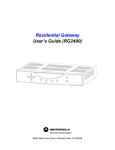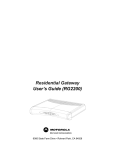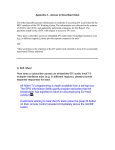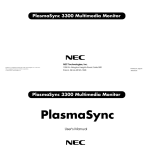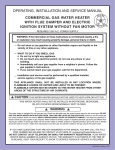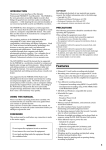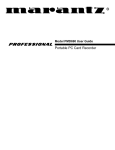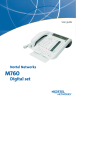Download Motorola RG3000 User`s guide
Transcript
Residential Gateway User’s Guide (RG3000) 5789 State Farm Drive • Rohnert Park, CA 94928 MOTOROLA the Stylized M Logo and Next Level Communications are registered in the US Patent & Trademark Office. Other trademarks are the property of their respective owners. All other products or company names are used for identification purposes only and may be trademarks of their respective owners. Copyright © 2005 by Motorola Inc. / Next Level Communications. All rights reserved. Computer programs referred to in this documentation contain confidential and proprietary information of Motorola / Next Level Communications. Information contained in this document is subject to change without notice. Motorola / Next Level Communications assumes no responsibility for any errors that may appear in this document, nor liability for any damages arising out of the use of this document. No part of this document may be reproduced in any form by electronic or mechanical means (including photocopying, recording, or information storage and retrieval) without permission in writing from Motorola / Next Level Communications. MGBI 527706 December 2005 TABLE OF CONTENTS IMPORTANT SAFEGUARDS ............................................................................... 5 Safety ...........................................................................................................6 Repairs .........................................................................................................6 INTRODUCTION ............................................................................................... 7 About This Manual .......................................................................................7 What Your Network Service Provider Does ..................................................8 GETTING STARTED ......................................................................................... 9 Using Your RG3000 .....................................................................................9 AC Outlet ....................................................................................................10 Using Your Remote Control ........................................................................ 11 Caller ID/Message Waiting .........................................................................13 Using Pay-Per-View ...................................................................................14 Access Parental Control .............................................................................14 Closed Captioning ......................................................................................15 Recording Your Favorite Programs ............................................................15 Cancelling Your Recording .........................................................................16 Programming Your VCR Code (Optional) ..................................................16 ADVANCED USE ............................................................................................ 17 Changing or Programming Settings ...........................................................17 Determine the remote control Operating Mode ..........................................17 Set the remote control Operating Mode .....................................................17 Determining the Gateway ID ......................................................................18 Setting the Gateway ID ..............................................................................19 Determining the Remote Control ID ...........................................................20 Setting the Remote Control ID ...................................................................20 Programming the TV Code ........................................................................20 Programming the TV Code Using Code Search Method ...........................21 Verifying the TV Codes ..............................................................................21 Verifying and Setting Other Features .........................................................22 Accessing the TV Setup Menu ...................................................................22 Verifying the TV (RF) Setting .....................................................................22 Secondary Audio: Specifying A Preferred Language .................................23 Display Language ......................................................................................24 EADS (Emergency Alert Device Support) ..................................................24 Aspect Ratio ...............................................................................................25 HD Component Output Resolution .............................................................26 HD Component Output 4:3 Override ..........................................................26 Closed Caption Display Settings ................................................................26 CONFIGURATION EXAMPLES .......................................................................... 29 Connections ...............................................................................................30 TROUBLESHOOTING ...................................................................................... 37 Possible Causes and Solutions ..................................................................37 Contacting Your Network Service Provider for Help ...................................38 TV AND VCR CODES.................................................................................... 39 TV Codes - SRC 300 .................................................................................39 VCR Codes ................................................................................................41 SPECIFICATIONS ........................................................................................... 43 Certifications ..............................................................................................43 FCC Statement of Compliance ...................................................................44 INDEX........................................................................................................... 45 IMPORTANT SAFEGUARDS READ INSTRUCTIONS – All the safety and operating instructions should be read before the product is operated. RETAIN INSTRUCTIONS – The safety and operating instructions should be retained for future reference. HEED WARNINGS – All warnings on the product and in the operating instructions should be adhered to. CLEANING – Do not use liquid or aerosol cleaners to dust this product. Use a cloth lightly dampened with water for cleaning. ATTACHMENTS – Do not use attachments that are not recommended as they may cause a hazard. WARNING – To reduce the risk of fire or electric shock, do not expose this apparatus to rain or moisture. Do not place this product on an unstable cart, stand, tripod, bracket, or table. The product may fall, causing serious personal injury and serious damage to the product. Use only with a cart, stand or table recommended by the manufacturer or sold with the product. Follow the manufacturer’s instructions when installing the product and use mounting accessories recommended by the manufacturer. A product and cart combination should be moved with care. Quick stops, excessive force, and uneven surfaces may cause the product and cart combination to overturn. VENTILATION – Slots and openings in the product housing are provided for ventilation, to ensure reliable operation of the product, and to protect it from overheating the following should be observed: • • • • • • • • • • Openings should never be blocked by placing the product on a bed, sofa, rug, or similar surface. Do not stack other equipment on top of the RG3000. Maintain at least 2 inches of free space above the RG3000. Do not install near heat sources such as radiators, heat registers, stoves or other apparatus (including amplifiers) that produce heat. POWER SOURCES – This product should be operated only from the type of power source indicated on the marking label. If you are not sure of the type of power supplied to your home, consult your local power company. For equipment intended to operate from battery power or other sources, refer to the operating instructions. GROUND OR POLARIZATION – This product may be equipped with a polarized alternating current line plug (a plug having one blade larger than the other). This plug will fit into the power outlet in only one way. This is a safety feature. If you are unable to insert the plug fully into the outlet, try reversing the plug. If the plug should still fail to fit into the outlet, contact an electrician to replace your obsolete outlet. Do not defeat the safety purpose of the polarized plug. POWER CORD PROTECTION – Power cords should be routed so they are not likely to be walked on or pinched by items placed upon or against them, paying particular attention to cords at plugs, convenience receptacles, and the point where the plugs exit from the product. POWER SOCKET OUTLET – Use a power socket outlet located near the equipment that is easily accessible. LIGHTNING – For added protection for this product during a lightning storm, or when it is left unattended, unplug it from the wall outlet. This will prevent damage to the video product due to lightning and power line surges. OVERLOADING – Do not overload wall outlets and extension cords, as this can result in a risk of fire or electrical shock. 5 • • • • OBJECT AND LIQUID ENTRY – Never push objects of any kind into this product through openings as they may touch dangerous voltage points or short-out parts that could result in a fire or electrical shock. Never spill liquid of any kind on the product. SERVICING – Do not attempt to service this equipment yourself as opening or removing covers may expose you to dangerous voltage or other hazards. Refer all servicing to qualified service personnel. DAMAGE REQUIRING SERVICE – Unplug this product from the wall outlet and refer servicing to qualified service personnel under the following conditions: • When the power supply cord or plug is damaged • If liquid has been spilled or objects have fallen into the equipment • If the product does not operate normally by following the operating instructions • If the product has been dropped or the housing has been damaged • When the product exhibits a distinct change in performance SAFETY CHECK – Upon completion of any service or repairs to the product, ask the service technician to perform safety checks to determine that the product is operating properly. SAFETY This section reviews important safety concepts for working with the optical and electrical equipment covered in this guide. SAFETY ADVISORIES AND LABELS Important warning notices, if any, are located on the back of the RG3000 about safety to people and equipment. Failure to observe these rules and similar danger, caution, or warning notices can result in serious personal injury, service interruption, and equipment damage. SYMBOLS Symbol Meaning Indicates “See instructions”. Indicates “Double Insulation”. Indicates “Use only with the cart, stand, bracket, tripod, or table specified by the manufacturer, or sold with the apparatus. When a cart is used, use caution when moving the cart/apparatus combination to avoid injury from tip-over”. REPAIRS If you find the unit in need of repair, contact your network service provider for repair or replacement. WARNING! Disconnect unit before servicing. 6 INTRODUCTION RG3000 Beneath the compact exterior of the RG3000 is a powerful media delivery system. The RG3000 is a single stream, VDSL settop capable of delivering HD (High Definition) television services1. The RG3000 provides high performance digital video and audio channels to the home (these services can include basic and premium video programming, Impulse Pay Per View, and music channels). Some units deliver sophisticated telephony services such as Caller ID and Message Waiting display. ABOUT THIS MANUAL The information in this manual is applicable to the RG3000C or RG3000V versions of the Residential Gateway RG3000. The term xDSL is a generic term, used in this manual to refer to VDSL technology. GETTING STARTED on page 9 contains the information you use most frequently and helps you understand how the RG3000 works after your NSP (network service provider) has connected and programmed its functions. It also describes how to use the RG3000 remote control to access and control the basic features of the RG3000. ADVANCED USE on page 17 provides more technical information about the RG3000 and gives instructions about how to set up and program your system. CONFIGURATION EXAMPLES on page 29 illustrates possible component wiring configurations of the RG in your system to aid you if you want to move your equipment or connect additional equipment such as an entertainment center or a new VCR. CONNECTING YOUR PC TO THE INTERNET on page 31 briefly explains connecting your PC to the Internet. Illustrations show configurations for setting up a LAN (local area network) in your home. TROUBLESHOOTING on page 37 provides help for problem resolution. 1. To take advantage of Component video (HDTV) service, the RG3000 must be connected to a High Definition television and be receiving high definition broadcast. 7 WHAT YOUR NETWORK SERVICE PROVIDER DOES The NSP (network service provider) is the company that installs your telephone service. During the initial installation your NSP does the following: • • • • • • Installs the RG3000 and connects it to your home entertainment system. Sets all features and services to which you have subscribed. Ensures that the remote control used with your RG3000 is the correct model. Installs the batteries in your remote control. Programs your remote control to operate your TV. Writes the remote control ID in the space provided (see form below). ABOUT RF CHANNELS Your NSP sets your TV to operate on a specific RF channel. This setting allows you to receive video and audio broadcast services. Programming the TV to an RF channel is similar to setting a TV to a specific channel, such as channel 3, in order to view movies played on your VCR. After the RF channel has been set, it is recommended that you do not change it, as you will no longer be able to receive programming unless you retune your TV to a new RF channel. Once your TV is tuned to the specified RF channel, the RG3000 and your remote allow you to surf through the channel line-up and tune to any program from any TV viewing location. The table below shows the association between the TV outputs and the RF channel. OUTPUT Ports RF Channel NETWORK IN/TV OUT and/or TV OUT 3 or 4 WRITE YOUR REMOTE CONTROL AND OTHER IDS HERE You may wish to label your remote control so you can easily identify it. Ask your service provider for labels if they have not already been provided for you. Write your remote control ID here: 8 Write your TV code here: Write your Gateway ID here: GETTING STARTED This section contains basic information needed to get you started using your new RG3000 right away. This information is covered in the following subsections: • • • • • • • • • • • • “Using Your RG3000” on page 9 “Using Your Remote Control” on page 11 “Changing Channels” on page 12 “Controlling TV Volume” on page 12 “Setting Up Channel Order and Your Favorite Channel List” on page 12 “Caller ID/Message Waiting” on page 13 “Using Pay-Per-View” on page 14 “Access Parental Control” on page 14 ”Recording Your Favorite Programs” on page 15 ”Cancelling Your Recording” on page 16 ”Programming Your VCR Code (Optional)” on page 16 “SRC-300A Remote Control Keys” on page 11 USING YOUR RG3000 The figure below shows the buttons you need to be familiar with when using the RG3000. See the following table for descriptions of their functions. Cursor Up Cursor Left Menu Select Cursor Down Cursor Right Power Guide Info Channel Down Channel Up The following table describes the buttons on the front of the RG3000. Button Name Button function Cursor Up Moves the cursor up, one position at a time, within the current application. Cursor Left Moves the cursor left, one position at a time, within the current application. Select Selects the current item. Cursor Down Moves the cursor down, one position at a time, within the current application. Cursor Right Moves the cursor right, one position at a time, within the current application. 9 Button Name Power Button function ■ ■ ■ ■ Exits any active application. Initiates power off sequence (either shows message/time display or power off channel depending on local settings). Toggles Power LED and the AC outlet (turns both LED and AC outlet on and off). Reboots (restarts) the RG3000 if pressed and held for 5 seconds or more. Menu Displays the Gateway Menu. Info Displays information about the currently selected channel. Guide Displays the program guide. Channel Up Increases the channel number. Channel Down Decreases the channel number. Messages LED On LED Remote LED Clock Display The following table describes the LEDs on the front of the RG3000. RG3000 LED LED Function Messages LED A lit LED indicates one or more voice mail messages are present. Power (On) LED Lit when the AC outlet is switched on. Remote LED Briefly lit when a remote control key is pressed (using the remote tuned to the first stream or primary TV). Indicates that remote keystroke activity is being seen by the settop. Clock Display (4-character display) ■ When the LED is off, there are no voice messages present. Blinks off and on during the startup process. ■ ■ ■ Under normal operation, this display shows the current time. When the user changes channels, this display will display the channel selected for a few seconds, and then return to presenting the current time. Hardware Signoff - If the xDSL connection is lost or broken, the two characters on the left display a circling pattern, the two on the right will not be lit. Software Signoff - If the xDSL connection is established but the system is unable to establish software signon, the two characters on the left display a circling pattern and the two characters on the right display a similar pattern. AC OUTLET The RG3000 has an AC outlet on the rear of the unit. Other devices can be plugged into this outlet. The outlet is on when the RG3000 is powered up. If you find that the outlet is off when the RG3000 is on, any press on the remote control turns the AC outlet back on. 10 USING YOUR REMOTE CONTROL The model SRC-300A remote control is to be used with the RG3000. The remote control allows you to control TV viewing from anywhere in your home. Your NSP (or yourself) can program it to operate your TV as well as your RG3000. The remote control operates by sending IR (infrared) signals to the RG3000. Your Network Service Provider programs your remote to operate in your home. Your remote control requires a direct line-of-sight to function. In other words, you need to point the remote directly at the TV or the RG3000. Keys and functions are described in the following. SRC-300A REMOTE CONTROL KEYS A. LED: Lights when any button on the remote is pressed. Also, when pressed and held starts programming sequences. B. Exit: Exits the current function. C. Directionals: Move cursor in program guide and menus. D. Info: Displays current channel and program guide and menus. E. Day back: Moves program guide back 24 hours. F. Fav: Scans through favorite channels. G. Vol: Adjusts TV volume. H. Last: Tunes to last channel. I. Call ID: Opens caller ID screen. J. Home*: Displays web browser, if provided. K. Number pad: Selects channels. L. Mute: Mutes and unmutes TV sound. M. Power: Powers TV on/off and tunes to default channel. N. A, B, C, D and Text*: Reserved for Teletext functions. O. Page up and down: Pages up and down in program guide and menus. P. Select: Selects highlighted option. Q. Day forward: Moves program guide forward 24 hours. R. Play*, Record, Pause*, and Stop*: Video on demand controls. S. Ch. Changes program channel. T. Guide: Displays interactive program guide. U. PPV: Displays pay per view menu. V. VOD*: Launches VOD (video on demand) menu, if provided. W. Menu: Displays main menu. X. Back*: In the browser, moves back to the previous screen. M A N B C O D P E Q R F Fav G H I S T U Last Call ID VOD J V W K Mute L Back X * Key not present on simplified remotes. ACTIVATING THE RG3000 The RG3000 doesn’t have an on/off button. However, if your NSP has activated the “One Touch Power” option, the RG3000 can be put into a power saving mode when you use the POWER button on the remote to turn the TV off. It is reactivated when the TV is turned on using the same button. 11 CHANGING CHANNELS To change the channel using the remote control buttons do one of the following: • • • Press up or down on the channel key (labeled CHAN or Ch). Enter the channel number on the number key pad and press Select. Enter the channel number on the number key pad and wait 5 seconds; the RG3000 tunes to the channel entered. To change the channel using the RG3000 front panel buttons: • Press the up or down key on the front panel. CONTROLLING TV VOLUME To raise or lower the volume on your TV using your remote control, press up or down on the VOL key. TO MUTE OR UNMUTE THE TV VOLUME USING YOUR REMOTE CONTROL 1. Press the MUTE key on the remote to mute your TV. 2. Press it again to unmute the TV. SETTING UP CHANNEL ORDER AND YOUR FAVORITE CHANNEL LIST You can use the remote control to select what channels will appear in your guide, set up your TV channel order or create a list of your favorite channels. Once your favorite channel list is set up, it can be accessed by pressing the FAV button on your remote control. TO SELECT CHANNEL LIST 1. Press the MENU key on your remote control 2. 3. 4. 5. 6. 7. The Main Menu screen of your interactive program guide is displayed. Use the down (directional) key to highlight “Setup The Channels.” Press SELECT. An options screen is displayed. Use the down (directional) key to highlight “Select Channels.” Press SELECT. Follow the instructions on the screen using your remote control buttons. When you have completed your selection, press EXIT to return to the previous screen. TO ARRANGE THE CHANNEL ORDER 1. Press MENU. The Main Menu screen of your interactive program guide is displayed. 2. Use the up or down (directional) key to highlight “Setup The Channels.” 12 3. Press SELECT. An options screen is displayed. 4. Use the down (directional) key to highlight “Change Channel Order.” 5. Press SELECT. 6. Follow the instructions in the interactive program guide. 7. When you have completed your selection, press EXIT to return to the previous screen. TO CREATE A FAVORITE CHANNEL LIST 1. Press MENU. The Main Menu screen of your interactive program guide is displayed. 2. Use the down (directional) key to highlight “Setup The Channels.” 3. Press SELECT. 4. 5. 6. 7. An options screen is displayed. Use the down (directional) key to highlight “Favorite Channels.” Press SELECT. Follow the instructions in the interactive program guide to select your favorite channels. When you have completed your selection, press EXIT to return to the previous screen. User Tip: Selecting channels to be included in the Favorite Channel List can also be performed in Pay-Per-View and when in the program guide menu. Now, whenever you access the program guide or press the FAV key on your remote control, the channels will be listed in the order you selected. REPLACING REMOTE CONTROL BATTERIES 1. Remove the battery compartment cover by holding the remote control with its back facing you, then pressing the battery cover at the thumb depression and sliding it off. 2. Install two 1.5V AA alkaline batteries, aligning positive and negative terminals according to the diagrams in the battery compartment. 3. Replace the remote control battery cover, snapping it into place. 4. Press the Power button on the remote control. CALLER ID/MESSAGE WAITING Note: The model RG3000C supports Caller ID. The model RG3000V does not support Caller ID. If you have subscribed to Caller ID, Voice Mail or Call Waiting services with your NSP, these capabilities are enabled as soon as the RG3000 is connected to the network. When an incoming call arrives, the message LED on the front of the RG3000 is illuminated and caller ID information appears in the upper left-hand corner of each of the TVs that is caller-ID enabled. The information may include some or all of the following, depending on the services available in your area. 13 • • The caller’s name The caller’s number You may also receive messages indicating the following conditions. • • Incoming call from: John Smith 555-1122 The caller is out of the area The caller ID information is unavailable Some of the caller information received is marked as private. All caller ID information is added to the Call Log. The RG3000 maintains a log of the last 50 calls. Information that is unavailable appears in the Call Log as unavailable or private. The log includes: • • • • The caller’s name The caller’s number The date of the call The time of the call TO VIEW THE CALL LOG 1. Press the CALL ID key on your remote control. The Caller ID Log is displayed. New calls appear with an asterisk (*) and highlighted text. User Tip: Make changes to your Caller ID and Voice Mail setups by pressing the MENU button and then selecting “Telephone Services.” 2. Use the up or down (directional) keys to scroll through the list of calls in the Call Log. Or, use the PAGE UP or PAGE DOWN buttons to scroll through pages of calls. 3. Press EXIT when you have finished. USING PAY-PER-VIEW The RG3000 allows you purchase and cancel Pay-Per-View programs and create passwords that control the ability to purchase programs. 1. Press the PPV key on your remote control. The interactive pay-per-view program guide is displayed. 2. Use your remote control and follow the instructions in the interactive program guide. ACCESS PARENTAL CONTROL The RG3000 allows you to use parental discretion about the TV programs or movies you want your children viewing. This “parental lock” is easily set up and removed using your remote control. You can control access by limiting access by channel, by rating and content, or by time. 1. Press MENU on your remote control. 14 2. 3. 4. 5. 6. The Main Menu screen is displayed. Use the down (directional) key on your remote to highlight “Parental Control.” Press SELECT. An options menu is displayed. The options include: • Parental Control Locks • Setup Passwords Highlight the action you want to perform. Press SELECT. Follow the instructions on your interactive program guide. Important! If you have forgotten your password and are unable to access pay-per-view or the parental controls, contact your NSP and have them reset your password. CLOSED CAPTIONING The RG3000 supports closed captioning capability. Refer to ”Closed Caption Display Settings” on page 26 or to your TV’s instructions for more information on how to use closed captioning. RECORDING YOUR FAVORITE PROGRAMS User Tip: When you are connecting your RG3000 to a VCR that has more than one AV input, be sure to plug into the default, or primary input, which could be called AV-1 or L-1. Make sure that your NSP has connected the VCR to the RG3000. For examples of VCR connections See “Connections” on page 30. 1. Turn on your VCR. 2. Load the tape you want to record on. 3. Press GUIDE on your remote control. 4. Highlight the channel you wish to record. 5. Press SELECT. 6. Start the record function on your VCR. (Consult your VCR user’s manual for the correct procedure.) User Tip: If you don’t want caller ID or other messages to appear in a program you are recording, turn the caller ID feature off. See User Tip on page 14. SETTING UP YOUR RG3000 TO START YOUR VCR (OPTIONAL) Note: The IR Blaster (see illustrations on page 35) must be installed and your VCR(s) must be programmed into the RG3000 by your NSP before the RG3000 can be programmed to record your favorite program. If the IR Blaster hasn’t been installed, contact your NSP. Not all NSPs support use of the IR Blaster. To setup the RG3000: 1. Press GUIDE on your remote control. 2. Use the up or down key to highlight the program you wish to record. 15 3. Press SELECT. An options menu is displayed. 4. Follow the interactive program guide instructions to set up the times to you want start and stop the recording. User Tip: The record set up can be accessed from the Pay-Per-View menu so your pay-per-view selection can be recorded at the time you choose. When your programming is complete, the following occurs. • • Your VCR begins recording. The record LED on the front panel of RG3000 turns on. Note: You cannot change channels while the recording is in progress. CANCELLING YOUR RECORDING If you want to cancel a recording in progress: 1. Press SELECT on your remote control. 2. Use the right key to highlight “Cancel.” 3. Press SELECT. Your recording will be canceled. PROGRAMMING YOUR VCR CODE (OPTIONAL) Note: Not all NSPs support VCR codes. 1. Turn on VCR. 2. Put a recordable tape into the VCR. 3. Press Menu on the remote control. 4. 5. 6. 7. 8. 9. 10. 11. 16 The Main Menu is displayed. Use the down (directional) key to highlight “Setup VCR.” Press SELECT. An options menu is displayed. If you know your VCR brand and code, highlight “Quick VCR Setup.” See ”TV and VCR Codes” on page 39 for a list of compatible VCRs. Press SELECT. An interactive action menu is displayed. Follow the instructions in the menu. If you don’t know your VCR code, highlight “Complete VCR Setup.” Press SELECT. An interactive action menu is displayed. Follow the instructions on the menu. ADVANCED USE You will need the information in this section if you want to change the default settings that were set up by your NSP or reprogram your remote control because it is not working correctly. Note: Your NSP programs your RG3000 and remote control when your system is first connected. The NSP also programs the same Gateway ID (this is the ID of your RG3000) into your remote control. If there is more than one RG3000 in your home, your NSP programs the Gateway ID into each remote control that communicates with a specific RG3000. CHANGING OR PROGRAMMING SETTINGS By using the remote control, the RG3000 front-panel buttons, and on-screen menus, you can perform the following tasks. ■ ■ ■ ■ ■ ■ ■ Determine the remote control Operating Mode Set the remote control Operating Mode Determine the Gateway ID Set the Gateway ID Determine the Remote Control ID Set the Remote Control ID Program TV Code ■ ■ ■ ■ ■ ■ ■ Verify the TV RF channel Set the Display Language Set up Secondary Audio Set the EADS (Emergency Alert Device Support) display Set the Aspect Ratio Set the HD (high definition) resolution settings Set Closed Caption options DETERMINE THE REMOTE CONTROL OPERATING MODE 1. 2. 3. 4. Press the LED key for three seconds until the LED flashes. Press the INFO key. The LED stops blinking at this point and stays on solid. Press and release the D key. When the D key is released, the LED immediately turns off. Watch the LED. The Operating Mode is indicated by a blink sequence. A short burst of flickering blinks indicates a '0' (SRC200 Compatibility Mode) while a single blink indicates a '1' (SRC-300A Native Mode.) There is a 1-second pause before the LED turns on. Once the LED sequence has completed, the SRC-300A returns to normal mode operation. SET THE REMOTE CONTROL OPERATING MODE The SRC-300A remote control operates older RG models as well as newer models. To allow for this, the remote can be set to operate in either SRC-200 Compatibility Mode (to operate like the older remote control) or SRC300A Native Mode. When in SRC-200 Compatibility Mode, the SRC-300A transmits IR messages that use the same format as the older SRC-200 remote control (messages are 16-bits in length.) When in SRC-300A Native Mode, the SRC-300A transmits IR messages using the 18-bit message format. The default operating mode is SRC-200 Compatibility mode. To program the operating mode: 17 1. Press and hold the LED key until it starts to blink. If an invalid code is entered or a 20 second lapse in button presses occurs, the LED will turn off and the remote control will return to normal operation. You will need to begin the procedure from step 1. 2. Press the REC key. The LED stops blinking and stays solid. 3. Press and release the D key. The LED temporarily turns off. Releasing the key causes the LED to light up again. 4. Press 0 to select SRC-200 compatibility mode or 1 to select SRC-300A native mode. The new Operating Mode is then stored in the device. Important! If the Operating Mode had been 1 (SRC-300A Native Mode) and is now set to zero (SRC-200 Com- patibility Mode), then the Gateway ID is reset to zero and also stored in the device. Once changes have been made, the remote control resumes normal operation. If the value entered was not valid (a keypress other than 0 or 1,) the LED indicates the error by turning off immediately and the remote returns to normal operation. (All values in the device remain unchanged.) DETERMINING THE GATEWAY ID Check, ”Write Your Remote Control and Other IDs Here” on page 8. Your NSP may have already recorded the Gateway’s ID on this page or on the back of the remote. If the ID has not been recorded, perform the following steps. 1. Press the MENU button on the front panel of the RG3000. (See “Using Your RG3000” on page 9 for an illus- tration and description of this button and other buttons on the RG3000s.) The Gateway Menu screen will be displayed on your TV. Gateway Menu SEP 3 3:22 PM TV Setup Remote Control Setup Exit Use and , then press SELECT Use EXIT to return to program viewing 2. Use the down key on your remote control to move down to Remote Control Setup. 3. Press SELECT on your RG3000 or your remote control. 18 The Remote Control Setup screen will be displayed. Remote Control Setup NLCRGW Press Source or PPV button on Remote now Press EXIT to return to the main menu. 4. Press PPV on your remote control. The screen lists the ID for the remote and shows the Gateway ID. Remote Control Setup NLCRGW Press Source or PPV button on Remote now Remote ID for this Remote is: This remote is set to Control TV: The Gateway ID is set to: 1 1 (Ch 3) 000 Press EXIT to return to the main menu. If the Gateway ID programmed into your remote control does not match the Gateway ID of the RG3000, the system prompts you to reset the Gateway ID. For future reference, write down the Gateway ID number displayed in ”Write Your Remote Control and Other IDs Here” on page 8. 5. Press EXIT twice on your remote to exit the Remote Control Setup and Gateway Menus. SETTING THE GATEWAY ID 1. 2. 3. 4. Press the LED key and hold it down until the LED flashes rapidly. Press the REC key. The LED stops blinking at this point and stays on solid. Press the B key. The remote is now in programming mode. You can set the GATEWAY ID. Enter the 3-digit code assigned to your RG3000. The valid range is 004 - 999 for SRC-300As in native mode. For SRC-300As in SRC-200 Compatibility mode, the range is 004 - 255. Enter a number with 3-digits, even if it contains leading zeroes. Examples of valid values are: 009, 012, 354, or 988. If you entered the Gateway ID correctly, the LED blinks several times. If the value was not entered successfully, the LED goes off and the remote control returns to normal operation. Repeat the steps above to try again. See ”Determining the Gateway ID” on page 18 to verify the Gateway ID. 19 DETERMINING THE REMOTE CONTROL ID 1. Press the LED key for 3 seconds until the LED flashes. 2. Press the INFO key. The LED stops blinking at this point and stays on solid. 3. Press the A key and watch the LED. Following are the sequences of flashing that indicate how your remote control ID is programmed. • A short burst of flickering indicates a 0 (zero). A number of longer, steady blinks indicates a non-zero digit. A zero is the only valid value for use with an RG3000. • After blinking, the remote returns to normal operation. Number of flashes Rapid flickering (indiactes zero) Remote Control ID Mode For TV in the same room as your RG3000a IR (Infra Red) a. The RG3000 can only be used with the SRC-300A in IR mode and does not support UHF mode. SETTING THE REMOTE CONTROL ID Your NSP uses the following table when programming your remote control ID to work with each TV in your household. Remote Control ID 0 Operates TV Mode a Local TV--TV in same room as RG. Remote is set to operate in IR mode. IR a. The RG3000 can only be used with the SRC-300A in IR mode and does not support UHF mode. To program the remote control ID: 1. 2. 3. 4. Press the LED key and hold it down until the LED flashes rapidly. Press the REC key. The LED stops blinking at this point and stays on solid. Press the A key. The remote is now in programming mode. Enter the single-digit remote control ID from the table above. Note: Valid single-digit codes are 0, and 1. If you entered an invalid sequence or a 20-second lapse in button presses occurs, the LED turns off and the remote control returns to standard operation. If you correctly entered the single-digit code, the LED flashes on and off and then remains off. PROGRAMMING THE TV CODE Your Network Service Provider programs your remote control to work with your TV by way of a TV code. The TV Code is a specific code for each brand and model of TV. When a TV code is set, the remote control is ready to operate the TV. The TV codes can be programmed manually, or they can be scanned. Each of the methods is described below. 20 Follow the steps below to program the TV code when you already know the three-digit code. (For a list of codes, see ”TV and VCR Codes” on page 39.) 1. 2. 3. 4. Press the LED key and hold it down until the LED flashes rapidly. Press the REC key. The LED stops blinking at this point and stays on solid. Press and release the C key. The remote is now in programming mode. Enter the three-digit code that corresponds to the brand name of the TV. See “TV Codes - SRC 300” on page 39. If the code is valid, the LED will flash on and off three times and then remain off. If an invalid code is entered or a 20 second lapse in button presses occurs, the LED will turn off and the remote control will return to normal operation. You will need to repeat the above procedure to program the TV code. PROGRAMMING THE TV CODE USING CODE SEARCH METHOD To program a TV code by using the search or scan method: Press the LED key and hold it down until the LED flashes rapidly. Press the REC key. The LED stops blinking at this point and stays on solid. Press and release the POWER key. The remote is now in TV code scan programming mode. Press the up key to scan through all TV codes. When you reach the correct TV code, the TV will automatically turn on, or off if it was previously on. Note that the LED will flash rapidly once you have scanned through all the codes, and then it will continue to go through the codes again in a continuous wrap. 5. Press the SELECT button to store the TV code. The LED flashes rapidly, then stops, indicating that the TV code has been stored. 6. If you press the up key too rapidly, you may pass the TV code before the time the TV turns on or off. If you are not sure you are storing the correct TV code, press the down key slowly to cycle back through codes that have been previously scanned. 7. When the TV turns off, or on if it was previously off, press SELECT at that point to store the TV code. 1. 2. 3. 4. VERIFYING THE TV CODES To playback the TV code: 1. 2. 3. 4. Press the LED key and hold it down until the LED flashes rapidly. Press the INFO key. The LED stops blinking at this point and stays on solid. Press and release the C key. The remote is now in playback mode. Observe the LED. The TV code will be indicated by a blink sequence for each number. See example below. For example, code 130 would show as the following: <pause> <long blink> <off> (represents 1) <pause> <long blink> <long blink> <long blink><off> (represents 3) <pause> <short burst of flickering blinks> <off> (represents 0) 21 VERIFYING AND SETTING OTHER FEATURES The TV Setup menu allows you to read and set the TV RF settings, as well as set Secondary Audio, Display Language, the EADS display, TV aspect ratio, and closed captioning options. Access these from the TV Setup Menu. ACCESSING THE TV SETUP MENU To access TV Setup Menu: 1. Press the MENU button on the front panel of the RG3000. The Gateway Menu is displayed on your TV screen. Gateway Menu SEP 3 3:22 PM TV Setup Remote Control Setup Exit Use and , then press SELECT Use EXIT to return to program viewing 2. Use the down or up key on the RG3000 or the remote to highlight TV Setup. 3. Press the SELECT button on the RG3000 or the remote control. The TV Setup menu is displayed on your TV screen. TV Setup Menu SEP 3 3:22 PM TV1 Closed Captioning Position Graphics Display Exit Use and , then press SELECT Use EXIT to return to program viewing Note: The [Position Graphics Display] option is unused. VERIFYING THE TV (RF) SETTING 1. Press the MENU button on the RG3000 front panel. The Gateway Menu is displayed. 22 2. 3. 4. 5. Use the down or up key on the RG3000 or the remote control to scroll to TV Setup. Press SELECT. The TV Setup Menu will be displayed on your TV. Use the down or up key on the remote control to highlight “TV1.” Press SELECT. The Setup 1 menu will be displayed. The selected RF setting is displayed, in this case channel 3 has been selected. Setup 1 SEP 3 TV (RF) Channel Secondary Audio Display Language Emergency Alert Device Support TV DVI/YPbPr Output 4:3 Override 3:22 PM 3 Spanish English OFF 16:9 1080i OFF Use and To select item. Use and to change value Use EXIT to return to previous menu Note: Your Network Service Provider sets up the initial RF channel setting and your TV to provide program channels by programming the output to a specific RF channel. If you need to change the RF channel settings, it is recommended that you call your NSP to do this for you. 6. Press the EXIT button twice to exit back to the program screen. SECONDARY AUDIO: SPECIFYING A PREFERRED LANGUAGE Secondary audio allows you to select a preferred language for each TV. Your NSP may deliver up to four audio programs with each video program. Your NSP may specify, for example, English as the first language, Spanish as the second, French as the third and so on. If the preferred language is available, the alternate language audio track will be transmitted with the video program. If a selected language is not provided on a particular channel, the RG3000 defaults to the primary language provided with the program. For example, if you are watching a Spanish-only channel, Spanish audio is played regardless of the Secondary Audio Display option. 1. Press the MENU button on the RG3000. 2. 3. 4. 5. 6. 7. The Gateway Menu is displayed. Use the up and down keys to highlight the TV Setup option. Press SELECT. The TV Setup menu is displayed. Use the up and down keys to highlight “TV1.” Press SELECT. The Setup TV# menu is displayed. Use the up or down key on your RG3000 or remote control to highlight Secondary Audio. Use the left and right keys to cycle through the alternate languages until the language you want is displayed. 23 8. Press the EXIT button twice to return to the program screen. DISPLAY LANGUAGE 1. Press the MENU button on the RG3000. 2. 3. 4. 5. 6. 7. 8. 9. The Gateway Menu is displayed. Use the up and down keys to highlight the TV Setup option. Press SELECT. The TV Setup menu is displayed. Use the up and down keys to highlight “TV1.” Press SELECT. The Setup menu is displayed. Use the up or down key on your RG3000 or remote control to highlight Display Language. Press the right key to highlight the default language. Continue to press the right key in the language field until the language you want appears. Available languages are English, Spanish (Espanol), and French (Francais). When you have selected the preferred language, press EXIT to return to the Main Menu screen. EADS (EMERGENCY ALERT DEVICE SUPPORT) Your NSP enables the EADS (Emergency Alert Device Support) when service is established. If you would like to disable or change the EADS settings, use the following directions: 1. Press the MENU button on the RG3000. 2. 3. 4. 5. 6. 7. 8. 24 The Gateway Menu is displayed. Use the up and down keys to highlight the TV Setup option. Press SELECT. The TV Setup menu is displayed. Use the up and down keys to highlight “TV1.” Press SELECT. The Setup menu appears on your TV screen. Use the up and down keys to highlight Emergency Alert Device Support. Press the right or left keys to enable/disable Emergency Alert Device Support. Press EXIT to return to the previous menu. If Emergency Alert Device Support is enabled, the following occurs for all EAS (Emergency Alert System) broadcasts: • You hear a two-tone attention signal during Emergency Alert broadcasts. • The RG3000 automatically tunes your TV to the channel that is broadcasting the EAS message. • The emergency message appears at the top of your TV screen. A FLASH FLOOD WARNING HAS BEE If EADS is not enabled, one of the following occurs, depending on the type of EAS broadcast: • You hear a two-tone attention signal. Flash Flood Warning Tune to Channel 6 for information • • A pop-up message appears on your TV screen to advise you of what type of emergency has occurred and the channel you should tune for more information. The RG3000 automatically tunes your TV to the channel that is broadcasting the EAS message. Note: For national and required monthly testing alerts, the RG3000 automatically tunes the TV to the EADS channel. ASPECT RATIO 1. Press the MENU button on the RG3000. 2. 3. 4. 5. 6. 7. 8. The Gateway Menu is displayed. Use the up and down keys to highlight the TV Setup option. Press SELECT. The TV Setup menu is displayed. Use the up and down keys to highlight “TV1.” Press SELECT. The Setup menu is displayed. Use the up or down key on your RG3000 or remote control to highlight “TV.” Press the right key to highlight the setting. Continue to press the right key in the field until the setting you want appears. 25 The default setting is 16:9. Other choices include 4:3 pan/scan and 4:3 letterbox. Try out different settings to see which you prefer. 9. When you have completed your selection, press EXIT to return to the Main Menu screen. HD COMPONENT OUTPUT RESOLUTION 1. Press the MENU button on the RG3000. 2. 3. 4. 5. 6. 7. 8. 9. The Gateway Menu is displayed. Use the up and down keys to highlight the TV Setup option. Press SELECT. The TV Setup menu is displayed. Use the up and down keys to highlight “TV1.” Press SELECT. The Setup menu is displayed. Use the up or down key on your RG3000 or remote control to highlight “DVI/YPbPr Output.” Press the right key to highlight the setting. Continue to press the right key in the field until the setting you want appears. The default setting is 1080i. Other choices include 720p (720 progressive) and 480p (480 progressive). Try out different settings to see which you prefer. When you have completed your selection, press EXIT to return to the Main Menu screen. HD COMPONENT OUTPUT 4:3 OVERRIDE 1. Press the MENU button on the RG3000. 2. 3. 4. 5. 6. 7. 8. The Gateway Menu is displayed. Use the up and down keys to highlight the TV Setup option. Press SELECT. The TV Setup menu is displayed. Use the up and down keys to highlight “TV1.” Press SELECT. The Setup menu is displayed. Use the up or down key on your RG3000 or remote control to highlight “4:3 Override.” Press the right key to highlight the setting. Continue to press the right key in the field until the setting you want appears. The default setting is “Off.” You may also choose 480p (uses 480p output resolution for 4:3 content). Try out different settings to see which you prefer. Note: You might notice a momentary loss of video signal. This loss is due to the TV tuning to the new resolution. 9. When you have completed your selection, press EXIT to return to the Main Menu screen. CLOSED CAPTION DISPLAY SETTINGS 1. Press the MENU button on the RG3000. The Gateway Menu is displayed. 26 2. Use the up and down keys to highlight the TV Setup option. 3. Press SELECT. The TV Setup menu is displayed. 4. Use the up and down keys to highlight “Closed Caption.” 5. Press SELECT. The Closed Caption menu is displayed. Setup 1 SEP 18 Closed Caption Status Service Selection Restore Defaults Pen Size Font Style Foreground Color Foreground Opacity Background Color Background Opacity Edge Type 1:42 PM Enabled Primary Language No Auto Auto Auto Auto Auto Auto Auto Use and To select item. Use and to change value Use EXIT to return to previous menu 6. Use the up or down key on your RG3000 or remote control to highlight the item you want to change. 7. Press the right key to highlight the setting. 8. Continue to press the right key in the field until the setting you want appears. Try out different settings to see which you prefer. Settings are listed in the table below. 9. When you have completed your selection, press EXIT to return to the Main Menu screen. Option Closed Caption Status Settings ■ ■ Service Selection ■ ■ ■ ■ ■ ■ Restore Defaults ■ ■ Pen Size ■ ■ ■ ■ Font Style ■ ■ ■ ■ ■ ■ ■ ■ ■ Disabled - closed captioning is off Enabled - closed captioning is on. Primary Language - Captions in the predominate language of the region Secondary Language - Captions in the secondary language of the region (if available) Language 3 - Additional language service defined by system operator Language 4 - Additional language service defined by system operator Language 5 - Additional language service defined by system operator Language 6 - Additional language service defined by system operator Yes - Restore closed captioning configuration defaults No - Retain user preferences Auto - Uses the caption author’s recommendation Small Standard Large Auto - Uses the caption author’s recommendation Default Mono serif Proportion serif Mono no serif Proportion no serif Casual Cursive Small 27 Option Foreground Color Settings ■ ■ ■ ■ ■ ■ ■ ■ ■ Foreground Opacity ■ ■ ■ ■ ■ Auto - Uses the caption author’s recommendation White Black Red Green Blue Yellow Magenta Cyan Auto - Uses the caption author’s recommendation Solid Flashing Translucent Transparent Background Color (same options as Foreground Color) Background Opacity (same options as Foreground Opacity) Edge Type ■ ■ ■ ■ ■ ■ ■ 28 Auto - Uses the caption author’s recommendation None Raised Depressed Uniform Left drop shadow Right drop shadow CONFIGURATION EXAMPLES Your Network Service Provider installs the RG3000 and connects all your electronic devices to the RG3000. However, you may need the information in this section if you ever want to do any of the following: • • • Move existing devices to a different location Add new devices to your system Reconfigure existing connections Note: The RG3000 should be located in the same area as your TV and home entertainment system. When you rearrange your equipment, be sure to unplug and plug in your equipment in the following order: 1. 2. 3. 4. Unplug all electronic devices, including the TV, VCR, and RG3000. Disconnect all cables between your electronic devices. Make your planned changes. Reconnect the cables between these devices. User Tip: When you are plugging your RG3000 in to a VCR that has more than one AV input, be sure to plug your RG3000 into the default, or primary input, which could be called AV-1 or L-1. Consult your VCR user’s manual. 5. After you have connected the cables, first plug in the RG3000. RG3000 back panel NETWORK IN TV OUT ETHERNET NETWORK IN S-VIDEO 1 1. 2. 3. 4. 5. 6. 7. 8. 9. 10. 11. 2 3 4 Y L Pb R Pr CVBS 5 6 AC-3 TEL LINE IR BLASTER AUX POWER 120 V ~ 50-60 Hz 3.0A MAX 7 8 9 120 V ~ 50-60 Hz 3.3A MAX 10 11 ETHERNET (unused) NETWORK IN NETWORK IN/TV OUT S-VIDEO HDTV: Y, PB, and Pr1 Audio L, R, and CVBS (composite video) DIGITAL AUDIO (Dolby Digital or AC-3 on S/PDIF connector) Telephone Line2 IR BLASTER AC Power AC Outlet 1. Required connections for Component video (HDTV). 2. On model RG3000C only; not available on RG3000V. 29 CONNECTIONS Basic HDTV Connections NETWORK IN TV OUT ETHERNET NETWORK IN S-VIDEO Video In 1 3 4 Y L Pb R Pr CVBS AC-3 IR BLASTER AUX POWER 120 V ~ 50-60 Hz 3.0A MAX HD/DVD IN 6 5 Monitor Audio Out Out TEL LINE 120 V ~ 50-60 Hz 3.3A MAX AUX Y S-Video Pb To Converter Pr Video In VHF/UHF L Audio L Audio R Audio R Control S In Out TV OUT (VHF) to TV NETWORK IN TV OUT ETHERNET NETWORK IN S-VIDEO Y L Pb R Pr CVBS Video In 1 3 4 Monitor Audio Out Out AC-3 TEL LINE IR BLASTER AUX POWER 120 V ~ 50-60 Hz 3.0A MAX HD/DVD IN 6 5 AUX S-Video To Converter Video In VHF/UHF Audio L Audio R Control S In 30 Out 120 V ~ 50-60 Hz 3.3A MAX VIDEO (composite)/AUDIO-L/AUDIO-R to TV NETWORK IN TV OUT ETHERNET NETWORK IN S-VIDEO Y L Pb R Pr CVBS AC-3 TEL LINE IR BLASTER AUX POWER 120 V ~ 50-60 Hz 3.0A MAX 120 V ~ 50-60 Hz 3.3A MAX TV Video In 3 1 4 Monitor Audio Out Out HD/DVD IN 6 5 AUX S-Video To Converter Video In Audio L VHF/UHF Audio R Control S In Out S-VIDEO/AUDIO-L/AUDIO-R to TV NETWORK IN TV OUT ETHERNET NETWORK IN S-VIDEO Y L Pb R Pr CVBS AC-3 TEL LINE IR BLASTER AUX POWER 120 V ~ 50-60 Hz 3.0A MAX 120 V ~ 50-60 Hz 3.3A MAX TV VHF/UHF IN Video1Video2 S-Video Video In Audio L Audio R 31 TV OUT (VHF) to VCR/TV NETWORK IN TV OUT ETHERNET NETWORK IN S-VIDEO Y L Pb R Pr CVBS TEL LINE AC-3 IR BLASTER AUX POWER 120 V ~ 50-60 Hz 3.0A MAX 120 V ~ 50-60 Hz 3.3A MAX VCR ANTENNA IN OUT TO TV TV Video In 1 3 4 Monitor Audio Out Out HD/DVD IN 6 5 AUX Y S-Video Pb To Converter Pr Video In VHF/UHF L Audio L Audio R Audio R Control S In Out Composite VIDEO with AUDIO-L/AUDIO-R to VCR and TV NETWORK IN TV OUT ETHERNET NETWORK IN S-VIDEO Y L Pb R Pr CVBS AC-3 TEL LINE IR BLASTER AUX POWER 120 V ~ 50-60 Hz 3.0A MAX 120 V ~ 50-60 Hz 3.3A MAX VCR VIDEO IN VIDEO OUT AUDIO IN AUDIO OUT TV VHF/UHF IN Video1Video2 S-Video Video In Audio L Audio R 32 S-VIDEO and AUDIO-L/AUDIO-R to audio receiver and TV NETWORK IN TV OUT ETHERNET NETWORK IN S-VIDEO Y L Pb R Pr CVBS AC-3 TEL LINE IR BLASTER AUX POWER 120 V ~ 50-60 Hz 3.0A MAX 120 V ~ 50-60 Hz 3.3A MAX audio receiver AUDIO IN AUDIO OUT TV VHF/UHF IN Video1Video2 S-Video Video In Audio L Audio R S-VIDEO/Digital Audio to audio receiver and TV NETWORK IN TV OUT ETHERNET NETWORK IN S-VIDEO Y L Pb R Pr CVBS AC-3 TEL LINE IR BLASTER AUX POWER 120 V ~ 50-60 Hz 3.0A MAX 120 V ~ 50-60 Hz 3.3A MAX audio receiver DIGITAL AUDIO IN AUDIO IN AUDIO OUT TV VHF/UHF IN Video1 Video2 S-Video Video In Audio L Audio R 33 Basic home entertainment center NETWORK IN TV OUT ETHERNET NETWORK IN S-VIDEO Y L Pb R Pr CVB S AC-3 TEL LINE IR BLASTER AUX POWER 120 V ~ 50-60 Hz 3.0A MAX 120 V ~ 50-60 Hz 3.3A MAX TV VHF/UHF IN VCR Video1 Video2 S-Video Video In L R Audio L Video Out AUDIO IN VIDEO IN VIDEO OUT AUDIO OUT Audio R audio receiver AUDIO IN L R L R L L R AUDIO OUT R left speaker 34 SPEAKER OUT right speaker Advanced home entertainment center with Surround Sound (with Dolby Digital 5.1 capability) ETHERN ET NETWORK IN NETWORK IN TV OUT S-VIDEO Y L Pb R Pr CVBS TEL IR LINE BLASTER AC-3 AUX POWER 120 V ~ 50-60 Hz 3.0A MAX 120 V ~ 50-60 Hz 3.3A MAX TV VHF/UHF IN Video1 Video2 S-Video VCR Video Out Video In Audio L AUDIO IN VIDEO IN Audio R VIDEO OUT AUDIO OUT audio receiver AUDIO IN AUDIO OUT DIGITAL AUDIO IN FRONT CENTER BACK SURROUND AUDIO OUT left front speaker center speaker right front speaker left rear speaker right rear speaker woofer IR Blaster connection and positioning NETWORK IN TV OUT ETHERNET NETWORK IN S-VIDEO Y L Pb R Pr CVBS AC-3 TEL LINE IR BLASTER AUX POWER 120 V ~ 50-60 Hz 3.0A MAX 120 V ~ 50-60 Hz 3.3A MAX IR Blaster RG3000 front VCR cable from IR Blaster port IR Blaster 35 36 TROUBLESHOOTING POSSIBLE CAUSES AND SOLUTIONS This section describes what to do if your system is not working correctly. Study the following tables to find possible causes and solutions to the problem. Problem Remote doesn’t work Remote will not accept programming changes Possible Cause Try This Dead batteries. Change the batteries in your remote according to the instructions on page 11. Obstruction between the remote and the RG3000 or IR Transmitter. Make sure that nothing is on or blocking a clear line of sight between the RG3000 and the remote. Weak batteries. Replace batteries and reprogram. Remote, in IR mode, will Weak or dead batteries. not operate Obstruction between the remote and the TV. Make sure that nothing is on or blocking a clear line of sight between the TV and the remote. No sound MUTE is pressed on the remote control. Press MUTE on the remote to restore volume level. TV code not programmed. Refer to “Programming the TV Code” on page 20. TV or RG3000 may not be activated. Refer to “Getting Started” on page 9. Cable signal may not be reaching your home. Make sure all cables are connected properly and that your TV is tuned to the correct RF channel. If the baseband video output on the RG3000 is connected to the VIDEO IN input on the TV, make sure the TV is set to the correct video input. VCR may be set incorrectly. Check to see how the VCR is connected to the RG3000. If the baseband video output on the RG3000 is connected to the VCR, the VCR must be ON and programmed to VIDEO IN. No picture Replace batteries. Make sure VCR/TV is set to TV. Make sure the TV is set to the correct TV or video input. No picture Your RG3000 has recently To restart your RG3000, press and hold down the power button on the front received a software panel for 5 seconds. download. Sometimes after a download the system fails to operate. You may need to restart your RG3000. Picture is distorted Coaxial cable is disconnected or loose. Reconnect or tighten the cable. Blue or black TV screen No video supplied to TV. If VCR is connected using RCA jacks, VCR must be ON to provide picture. Snowy picture on all TVs VCR is on at this location and Call your NSP to reset your RF channel. TV is on wrong channel. TV is on wrong channel for Source. Call your NSP to reset your RF channel. Only one stereo speaker Audio connections are loose. Reconnect audio connections. has sound Check to make sure that no wires are frayed and no plugs are bent or broken. No power Power cord is disconnected. Check to make sure that the RG3000 is plugged into a live electrical outlet. Note: If the outlet is controlled by a wall switch, make sure the switch is on. 37 Problem VCR will not record Possible Cause Try This VCR is on wrong channel. See “Changing Channels” on page 12. VCR is programmed incorrectly. Refer to the VCR User’s Manual. VCR is not connected properly. See “Connections” on page 30. VCR is connected with RCA jacks and is not in correct mode. Place the VCR on the LINE input. This can be accomplished using the VCR menu or changing the VCR channel until the display on the VCR indicates LINE. Safety tab on tape is broken. Use a new tape. VCR will not play tapes Amber Network LED TV on wrong channel for playback or not using the correct input. Tune TV to correct RF channel. VCR is not connected properly. See “Connections” on page 30. The Gateway is not ready for Unplug power connection on back of Gateway then reconnect if light stays on use. more than 10 minutes. CONTACTING YOUR NETWORK SERVICE PROVIDER FOR HELP If you are unable to fix the problem yourself, contact your NSP for assistance. Depending on the problem you are having, your NSP may ask for your RG3000’s model number. To find out what the model number is: • • Press the MENU button on the front panel of the RG3000. The GATEWAY menu appears. Select Remote Control Setup. The model number appears in the upper right-hand corner of the screen. For example, RG2BV30000. Be sure that the remote control you are using came with your RG3000. Using more than one type of remote with the RG3000 does not work. Your NSP equips you with a remote control. For information about setting up and programming your system using the RG3000 remote control as well as setting up features such as Emergency Alert Services and Caller ID, see the second section of this manual, see “Advanced Use” on page 17. 38 TV AND VCR CODES TV CODES - SRC 300 This section lists TV models that are compatible with the SRC-300A. If you do not find the TV code you need in the list, call your NSP. TV and Codes TV and Codes Daewoo: 005, 010, 024, 027, 029, 030, 032, 098, 120, 130, 214, 215, 224, 247, 250, 252 Daytron: 006, 024, 098, 194, 224 DBX: 238 TV and Codes Kawasho: 061 Kenwood: 006, 235, 251 Kloss: 022, 110, 175 Konka: 236 AOC: 005, 006, 019, 024, 032, 120, 140 Denon: 052 Admiral: 003, 018, 041, 087, 125, 129, 187, 194, 210 LXI: 003, 005, 010, 027, 087, 125, 129, 131, 132, 194, 223, 251 Dimensia: 125 Lloytron: 098, 224 Dixi: 010, 027, 032, 120 Lodgenet: 018 Dumont: 001 Loewe: 010, 027 Electrohome: 072, 098, 149, 224, 240 Logik: 018 Luxman: 005 Amark: 032, 098, 120, 224 Emerson: 005, 017, 033, 035, 037, 038, 039, 041, 054, 098, 130, 132, 141, 143, 176, 181, 185, 187, 194, 203, 222, 223, 224, 225, 226, 227, 251, 252, 253 Amstrad: 033 Envision: 006 Anam: 005, 009, 021, 032, 041, 120, 121, 183 Fisher: 042, 099, 194, 217 MTC: 005, 006, 010, 016, 024, 027, 202, 251 Anam-National: 211 Funai: 024, 041, 132, 187, 251 Archer: 032, 120 Futuretech: 041 Audiovox: 024, 032, 041, 120, 130 GE: 003, 005, 008, 009, 043, 087, 125, 130, 143, 147, 165, 182, 183, 206, 210, 211, 228, 231, 233, 248 Aiko: 024 Aiwa: 194, 251 Akai: 000, 005, 006, 032, 070, 072, 075, 107, 108, 120, 135, 139, 149 Alaron: 187 Audio Dynamics: 238 BPL: 144 Bell & Howell: 018, 194 Broksonic: 005, 010, 027, 174, 176, 225, 226, 245 Fujitsu: 187 Goldstar: 005, 006, 010, 027, 045, 098, 168, 194, 223, 224, 230, 238 MGA: 005, 006, 071, 072, 149, 187, 194, 240 Magnasonic: 010, 024, 027, 129, 131, 187 Magnavox: 000, 005, 006, 008, 010, 017, 024, 025, 027, 054, 067, 068, 098, 110, 132, 154, 167, 175, 187, 194, 216, 224, 231, 237, 251, 254 Majestic: 018 Marantz: 005, 006, 010, 027, 068, 072, 149, 237, 238 Marta: 223 Gradiente: 057, 060 Matsui: 010, 027, 032, 109, 120 CXC: 041 Granada: 010, 027 Candle: 005, 006, 022, 025 Hallmark: 005 Memorex: 005, 018, 032, 072, 120, 149, 187, 194, 219, 223, 242, 244, 248, 251 Capehart: 019 Harman Kardon: 238 Midland: 001, 003, 087, 165 Carver: 010, 027 Hinari: 010, 027, 187 Centurion: 005, 006, 194 Hitachi: 005, 017, 018, 024, 048, 049, 050, 051, 052, 053, 054, 055, 098, 116, 126, 142, 160, 185, 224, 231, 251 Mitsubishi: 005, 006, 017, 054, 070, 071, 072, 123, 129, 149, 187, 194, 239, 240 Citizen: 005, 006, 010, 016, 018, 022, 024, 025, 027, 098, 202, 224 Concerto: 005, 010, 027 Contec: 017, 041, 054, 181, 185, 227 Corando: 098, 224 Coronado: 098, 224 Craig: 021, 041 Crown: 041, 098, 224 Curtis-Mathes: 005, 006, 010, 016, 018, 027, 059, 098, 125, 131, 194, 202, 210, 224, 231, 251 Multitech: 041, 251 NAD: 002, 005, 131, 166 Infinity: 010, 027 NEC: 005, 006, 007, 183, 191, 194 JBL: 010, 027 National: 008, 010, 011, 012, 027, 146, 190, 211 JC Penney: 003, 005, 006, 014, 016, 043, 072, 087, 096, 098, 125, 131, 149, 165, 194, 202, 206, 210, 223, 224, 231, 238, 242 Nikkai: 010, 027, 113, 131 Onwa: 041 JVC: 057, 059, 060, 234, 235, 238 Optimus: 012, 166, 194, 242 Jensen: 056 Optonica: 129 KEC: 041 Orion: 010, 027, 037, 176, 212, 225, 226 KMC: 098, 224 Osume: 017, 054 KTV: 005, 006, 039, 041, 098, 224 39 TV and Codes Panasonic: 008, 009, 010, 011, 012, 127, 148, 165, 177, 183, 211, 218, 231, 241, 242 Philco: 005, 006, 010, 024, 025, 027, 052, 067, 068, 072, 098, 110, 149, 175, 176, 183, 216, 224, 237, 251 Philips: 005, 006, 010, 025, 027, 068, 098, 136, 137, 138, 150, 220, 216, 223, 224, 237, 251 Pioneer: 002, 008, 048, 051, 076, 131, 166, 235 Portland: 005, 024, 098, 224 Proscan: 005, 125, 147, 152, 210, 233 Proton: 005, 006, 013, 019, 098, 224 Pulsar: 001, 024, 248 Quasar: 008, 009, 012, 165, 183, 211, 231, 242 RCA: 003, 005, 008, 014, 048, 063, 072, 078, 079, 080, 082, 084, 085, 086, 087, 125, 130, 147, 149, 160, 182, 183, 210, 231, 233, 251, 254 Radio Shack: 003, 005, 041, 072, 087, 098, 141, 149, 194, 224, 230, 242, 251 TV and Codes Supra: 005, 022 Sylvania: 005, 006, 010, 024, 025, 027, 068, 098, 110, 132, 175, 194, 224, 237, 240, 251 Symphonic: 132, 179, 251 TIVO: 136, 137, 138 TMK: 005 Tandy: 098, 113, 129, 224, 251 Tatung: 009, 010, 027, 183, 211 Teac: 251 Technics: 008, 012, 165, 242 Techwood: 005, 165 Teknika: 005, 010, 016, 018, 022, 024, 025, 027, 041, 072, 098, 114, 149, 187, 202, 223, 224, 251 Telerent: 018, 098, 224 Teletech: 032, 120 Thomson: 051, 116, 142 Toshiba: 016, 017, 054, 096, 131, 194, 202, 240, 245, 247 Totevision: 098, 223, 224 Realistic: 005, 006, 035, 041, 098, 141, 194, 222, 223, 224, 251 Universal: 043, 206 Runco: 001, 006, 243 Victor: 057, 060, 235 SAA: 145 Video Concepts: 070, 238, 251 SSS: 005, 041 Vidtech: 005 Saba: 051, 116, 142 Viking: 022 Saisho: 032, 033, 109, 120 Wards: 000, 005, 006, 010, 018, 027, 043, 067, 068, 125, 141, 182, 187, 194, 206, 224, 251 Sampo: 006, 019, 156, 194 Samsung: 005, 006, 010, 016, 027, 032, 098, 120, 155, 157, 167, 194, 202, 219, 221, 224, 229, 244, 246, 247 Vector Research: 006, 238 Westinghouse: 037, 041, 130, 176, 194 Yamaha: 005, 006, 238, 251 Sansui: 176, 225, 235, 251 Yorx: 006, 194 Sanyo: 042, 089, 092, 109, 184, 194, 217, 219, 244 Zenith: 001, 018, 024, 178, 223, 225, 235, 248, 249, 251 Scott: 005, 006, 037, 041, 093, 098, 187, 194, 224, 247 Zonda: 032, 120 Sears: 003, 005, 010, 016, 027, 042, 087, 096, 098, 099, 101, 102, 104, 125, 131, 132, 184, 187, 194, 202, 217, 223, 224, 251 Sharp: 017, 054, 098, 129, 141, 200, 224, 254 Signature: 010, 018, 027, 251 Sony: 000, 109, 180, 189, 232 Soundesign: 005, 025, 041, 187, 251 Spectricon: 032, 120 Starlite: 041 40 VCR CODES This table lists the VCR models and code numbers that are compatible with the IR Transmitter. If you do not find the code you need in the list shown, call your NSP. Not all NSPs support use of the IR Blaster. These codes are exclusively for use with RGs equipped with an IR Transmitter. VCR and Codes Admiral: 048, 209 Adventura: 000 Aiko: 278 Aiwa: 307, 000, 037 Akai: 106, 053, 041, 061 America Action: 278 American High: 035 Asha: 240 Audiovox: 037 Beaumark: 240 Bell & Howell: 104 Broksonic: 121, 184, 002, 209, 211, 479 CCE: 072, 278 Calix: 037 Canon: 035 Capehart: 020 Carver: 081 Cineral: 278 Citizen: 278, 037 Colt: 072 Craig: 037, 072, 047, 240, 271 Curtis Mathes: 035, 041, 060, 162 Cybernex: 051, 240 Daewoo: 278, 561, 020, 045 Daytron: 020 VCR and Codes VCR and Codes Funai: 000 Noblex: 240 GE: 035, 060, 048, 202, 240 Olympus: 035 Garrard: 000 Optimus: 162, 048, 058, 037, 104, 432 Go Video: 432, 526, 232 Optonica: 062 GoldStar: 037, 038 Orion: 479, 002, 184, 209 Gradiente: 008, 000 Panasonic: 035, 162, 077, 225, 616 Grundig: 195 Penney: 035, 240, 037, 042, 038, 040, 054 Harley Davidson: 000 Pentax: 042, 105 Harman/Kardon: 038, 081 Philco: 035, 209, 479 Harwood: 068, 072 Philips: 081, 035, 062 Headquarter: 046 Pilot: 037 Hitachi: 042, 105, 000, 041 Pioneer: 058, 067 HI-Q: 047 Portland: 020 Hughes Network Systems: 042 Profitronic: 240 JVC: 067, 008, 041 Proscan: 060, 202 Jensen: 041 Protec: 072 KEC: 037, 278 Pulsar: 039, 051 KLH: 072 Quarter: 046 Kenwood: 041, 067, 038 Quartz: 046 Kodak: 035, 037 Quasar: 035, 162, 077 LXI: 037 Lloyd's 000, 208 RCA: 060, 149, 202, 042, 105, 035, 048, 077, 106, 240 Logik: 072 Radio Shack: 000 MEI: 035 Radix: 037 MGA: 043, 061, 240 Randex: 037 MGN Technology: 240 Realistic: 000, 104, 047, 048, 037, 035, 062, 046, 066 MTC: 000, 240 Magnasonic: 278 Magnavox: 035, 081, 000, 039, 149 Magnin: 240 Marantz: 081, 035 Marta: 037 Matsushita: 035, 162 Denon: 042 Memorex: 104, 047, 000, 037, 048, 035, 046, 240, 307, 039, 209, 162 Dynatech: 000 Minolta: 105, 042 Electrohome: 037 Mitsubishi: 043, 173, 061, 048, 067 Electrophonic: 037 Motorola: 035, 048 Emerex: 032 Multitech: 000, 072 Emerson: 184, 002, 209, 278, 036, 121, 211, 208, 479, 561, 061, 088, 212, 000, 037, 043, 068 NAD: 058 Fisher: 047, 104, 054, 066 Nikko: 037 Fuji: 033, 035 Nikon: 034 NEC: 038, 040, 041, 067, 104 Ricoh: 034 Runco: 039 STS: 042 Samsung: 045, 051, 053, 240 Sanky: 039, 048 Sansui: 041, 479, 000, 067, 209, 271 Sanyo: 047, 046, 104, 240 Scott: 184, 211, 121, 043, 045, 210, 212 Sears: 054, 105, 037, 042, 000, 035, 046, 047, 066, 104 Semp: 045 Sharp: 048, 062 Shintom: 072 Shogun: 051, 240 Singer: 072 Sony: 033, 034, 032, 000, 035 Sylvania: 035, 081, 000, 043 41 VCR and Codes Symphonic: 000 TMK: 036, 208, 240 Tatung: 041 Teac: 000, 041 Technics: 035, 162 Teknika: 000, 035, 037 Thomas: 000 Toshiba: 045, 210, 212, 043, 066, 366 Totevision: 037, 240 Unitech: 240 Vector: 045 Vector Research: 038, 040 Video Concepts: 040, 045, 061 Videosonic: 240 Wards: 035, 060, 062, 000, 047, 212, 240, 042, 048, 072, 081, 149 White Westinghouse: 278, 209 XR-1000: 072, 000, 035 Yamaha: 038 Zenith: 039, 000, 033, 034, 209, 479 Note: The IR Transmitter is not compatible with: • • 42 Samsun VCR/TV model number CDX1342 Philips VCR model number VRX364AT SPECIFICATIONS Cabling Requirements Input/Output Cable (connector) ETHERNETa RJ-45, female NETWORK IN RJ-45, female NETWORK IN/TV OUT F-type coaxial, female S-VIDEO S-Video circular 4-position Mini-DIN, female Audio/Video: • Y (green) • Pb (blue) & • Pr (red) • AUDIO R (red) • AUDIO L (white) • CVBS (yellow) (composite video) RCA, female AC-3 (black) RJ-45 female optical TEL LINE b RJ-11 jack, female/male IR Blaster 3.5 mm phone jack, female AC IN 1 polarized, 2-prong plug AC outlet 2-prong a. This port is disabled on model RG3000. b. Not available on the RG300V. Power Requirements Condition Power Consumption (watts) normal operation <30 watts, 105-125VAC 60Hz Environmental Operating Temperature Range 0 to 40°C Humidity Range (non-condensing) Storage Temperature Range -40°C to + 80°C 5% to 95% Dimensions and weight Dimensions (L x W x H) 10.125 in. (25.73cm) x 14.75 in. (37.46cm) x 2.75 in. (6.95 cm) Weight 5.27 lbs (2.39 kilograms) CERTIFICATIONS • • • GR-1089-CORE FCC Title 47 Part 15, Class B UL 60950-1 43 • • • CSA C22.2 No. 60950-1-03 CE ASTM D (mechanical shock and vibration standards) FCC STATEMENT OF COMPLIANCE This device complies with Part 15 of the FCC Rules. Operation is subject to the following two conditions: (1) this device may not cause harmful interference, and (2) this device must accept any interference received, including interference that may cause undesired operation. NOTICE This equipment has been tested and found to comply with the limits for a Class B digital device, pursuant to Part 15 of the FCC Rules. These limits are designed to provide reasonable protection against harmful interference in a residential installation. This equipment generates, uses and can radiate radio frequency energy and, if not installed and used in accordance with the instruction manual, may cause harmful interference to radio communications. However, there is no guarantee that interference will not occur in a particular installation. If this equipment does cause harmful interference to radio or television reception, which can be determined by turning the equipment off and on, the user is encouraged to try to correct the interference by one or more of the following measures: • • • • • 44 Reorient or relocate the antenna. Reorient or relocate the receiving antenna. Increase the separation between the equipment and receiver. Connect the equipment into an outlet on a circuit different from that to which the receiver is connected. Consult the dealer or an experienced radio/TV technician for help. INDEX A H about this manual 7 Advanced Use 17 Aspect Ratio 25 HD output override 26 HD output resolution 26 B batteries remote control 13 buttons remote control 11 RG3000 9 RG3000, front panel 9, 10 C cable requirements 43 Certifications 43 changing channels 12 using the remote control 12 using the RG3000 buttons 12 channel list select 12 channel order favorite 12 setting up 12 Closed Caption display options 26 closed captioning 15 codes TV (SRC-300A) 39–40 VCR 41–42 Controlling TV Volume 12 I IDs Gateway, determining 18–19 Important Safeguards 5 Introduction 7 IR, about 11 L language alternatives 23–24 M message waiting 13 mute TV volume 12 N Network Access Provider finding 38 Network Service Provider Services 8 O Override 4 3, HD 26 P dimensions 43 Display Language 24 changing 24 down key, about 10 Parental Control 14 parental locks 14 pay-per-view using 14 plugging in devices 29 power requirements 43 preface 5 E R Emergency Alert Device Support 24–25 entertainment center 35 advanced, illustrated 35 basic, illustrated 34 recording your favorite programs 15 remote control 11 buttons (SRC-300A) 11 buttons, described 11 using 11 remote control ID setting 20 remote control ID form 8 Remote Control ID menu, illustrated 19 Remote Control Setup menu, illustrated 19 replacing remote control batteries 13 Resolution, HD 26 RF channels, about 8 RF settings 23 RF settings, verifying 22–23 RG3000 using 9 D F FCC statement of compliance 44 front panel buttons 10 G Gateway ID 19 determining 18–19 setting 17, 19, 21 Gateway Menu, illustrated 18, 22 Getting Started 9 RG3000 buttons, illustrated 9 RG3000 front panel Channel Down key, about 10 Channel Up key, about 10 Clock Display, about 10 Cursor buttons, about 9 Guide button, about 10 Info button, about 10 Menu button, about 10 Message LED, about 10 On LED, about 10 Power button, about 10 Power LED, about 10 Remote LED, about 10 Select button, about 9 replacing remote control batteries 13 snowy picture 37 VCR will not play tapes 38 VCR will not record 38 TV codes obtaining, using the code search method 21 programming 20 SRC-300A, list 39–40 TV Setup Menu, illustrated 22 TV volume controlling 12 TV/VCR/Audio Connections 30–35 TVs closed captioning 15 programming 22 S U Safety 6 advisories and labels 6 repairs 6 secondary audio 23 settings changing 17 programming 17 Setup Menu, illustrated 23 Setup TV menu 22 Specifications 43 SRC-300A remote control TV codes, list 39–40 Surround Sound, wiring illustrated 35 T temperature operating range 43 troubleshooting 37–38 blue or black screen 37 no picture 37 no power 37 no sound 37 picture distortion 37 remote control won’t change channels 37 unmute TV volume 12 unplugging devices 29 V VCR codes 41–42 programming 16 VCR, plugging into 29 VCR, using the RG3000 to start 15 video recording 15 W wiring advanced home entertainment center with Surround Sound 35 basic home entertainment center 34 composite video with AUDIO-L/AUDIO-R and TV 32 HDTV 30 S-VIDEO and AUDIO-L/AUDIO-R to audio receiver and TV 33 S-VIDEO/AUDIO-L/AUDIO-R to TV 31 TV OUT to TV 30 TV OUT to VCR/TV 32 VIDEO/AUDIO-L/AUDIO-R to TV 31














































